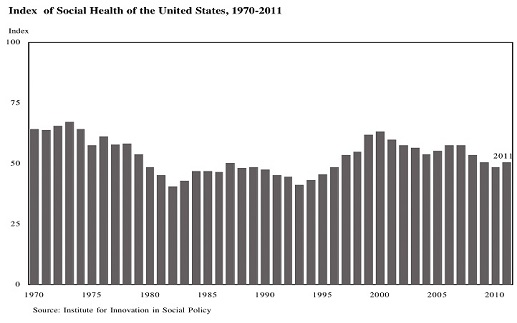The Index of Social Health
The Index of Social Health, the centerpiece of the Institute’s work, monitors the social well-being of American society. It has been released annually by the Institute (formerly the Fordham Institute for Innovation in Social Policy) since 1987. Like the Index of Leading Economic Indicators or the Gross Domestic Product, it is a composite measure that combines multiple indicators to produce a single number for each year.
The Index of Social Health is based on sixteen social indicators. These are: infant mortality, child abuse, child poverty, teenage suicide, teenage drug abuse, high school dropouts, unemployment, weekly wages, health insurance coverage, poverty among the elderly, out-of-pocket health-care costs among the elderly, homicides, alcohol-related traffic fatalities, food insecurity, affordable housing, and income inequality.
The premise of the Index is that American life is revealed not by any single social issue, but by the combined effect of many issues, acting on each other. In looking at social problems that affect Americans at each stage of life—childhood, youth, adulthood, and old age—as well as problems that affect all ages, the Index seeks to provide a comprehensive view of the social health of the nation.

Click here to view the numerical data as a table.
Most Recent Findings
In 2011 (the last year for which complete data are available), the Index of Social Health stood at 50.2 out of a possible 100—up 1.7 points from the previous year, but still five points below the most recent peak in 2007. This score is the second lowest in the past fifteen years, the only lower score being last year’s 48.5. Overall, between 1970 and 2011, the Index declined from 64.0 to 50.2, a drop of 21.6 percent.
The recent drop in the Index reflects the impact of the economic recession that began in late 2007. Although the recession officially ended in 2009, social indicators usually take longer to recover. It is to be hoped that the slight rise in the Index in 2011 will be followed by broader improvement, once the complete statistics for 2012 become available.
Indicators
The Index of Social Health is composed of sixteen indicators. Grouped by stage of life, they are as follows:
| Children | Adults | All Ages |
|---|---|---|
|
Infant mortality Child abuse Child poverty |
Unemployment Weekly wages Health insurance coverage |
Homicides Alcohol-related traffic fatalities Food insecurity Affordable housing Income inequality |
| Youth | Elderly | |
|
Teenage suicide Teenage drug abuse High school dropouts |
Poverty, ages 65 and over Out-of-pocket health-care costs, age 65+ |
The performance of the indicators since 1970 shows the following pattern:
| Progress | Lack of Progress |
|---|---|
Seven indicators have improved since 1970:
|
Nine indicators have worsened since 1970:
|
Click here for indicator Definitions and Sources for 2011 Index of Social Health.